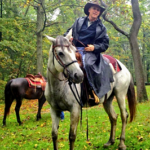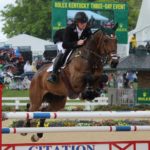With neck arched in pride, nostrils flared in excitement and ears pricked in anticipation, Il Cavallo stepped through the mists of time to take his rightful place among Milan, Italy’s, Renaissance monuments in 1999, more than 500 years after first taking form in Leonardo da Vinci’s imagination. The world’s largest equine statue, cast in bronze and engineered to stand for hundreds of years to come, was unveiled as a gift to Italy from the American people.

The colossal statue recognizes the genius of the Italian painter, sculptor, architect and engineer-the original Renaissance man-who conceived it, and celebrates the cultural, scientific and artistic legacy of the epoch that produced him. But Il Cavallo is also a monument to an American man who took an idea lost in time as the consuming mission of his last 16 years of life. And finally, it is the achievement of dedicated people resolving numerous artistic and technological challenges to keep a promise to a dying friend and take Leonardo’s most monumental creation home to Milan.
Il Cavallo’s story spans five centuries, beginning in 1482, when Ludovico Sforza, the Duke of Milan and Leonardo’s patron, commissioned an equestrian statue in honor of his father. Leonardo worked on the statue for 17 years, completing a 24-foot-tall clay sculpture that was to be cast in bronze. However, the political instability of late 15th century Italy proved to be the project’s undoing. In 1499, French forces invaded Milan, forcing Ludovico to use the bronze earmarked for the immense statue to build cannons instead. With the Milanese defeated, French archers used the clay model for target practice. What the conquering army didn’t destroy was left to the elements. Il Cavallo vanished from the earth to become a little-known footnote in Renaissance history.
There the statue might have remained but for a retired airline pilot and lover of the arts who happened upon a 1977 National Geographic article about Leonardo’s life and the story of his never-completed bronze horse. Charles Dent, of Fogelsville, Pennsylvania, eventually founded Leonardo da Vinci’s Horse, Inc. (LDVHI) to complete the Renaissance master’s vision that had been described in the article.
“It just kind of jumped off the page at him as a huge project by the master that was lost in history, but is hanging there as an unfinished idea. It was the romance of that that attracted him,” says Milan Kralik, an LDVHI trustee. “He saw things a little differently from anyone else. One of the first thoughts that jumped into his head was why didn’t anyone finish this project.”
The first step in Dent’s plan was to research Il Cavallo and see if there was enough material upon which to base an undertaking of this magnitude. After much travel and discussion with leading American and Italian Renaissance and Leonardo scholars, Dent got the affirmative responses he needed to go forward with his dream. In 1982, he founded the nonprofit, tax-exempt LDVHI to oversee and finance the production of the statue. The projected final cost of Il Cavallo is approximately $6.5 million. Over the years, contributions to the effort have ranged from $6.75 from a school class to an anonymous foundation grant of $675,000.
“We didn’t fit the profiles for corporate giving,” says Kralik. “It was mostly private contributions with a few foundations. It involved a lot of cold calling and grassroots fund-raising.” But when Dent died of Lou Gehrig’s disease on Christmas day of 1994, he left his private art collection to LDVHI, and its sale brought more than $1 million to the fund.
The Sculpture Begins
In 1988, LDVHI enlisted sculptor/painter Garth Herrick to begin part-time work on the horse. “Charlie and Garth studied the drawings like crazy, but it was very difficult to translate a two-dimensional drawing into a three-dimensional object,” says Kralik. “Their efforts were good but somewhat amateurish.”

By 1997, Tallix Art Foundry, in Beacon, New York, the company contracted by LDVHI to cast the horse, had suggested bringing Nina Akamu, a talented animal sculptor, on board to attempt to correct the anatomical faults of the Dent-Herrick horse. After several months of trying, Akamu determined that the original model could not be salvaged and concluded that a completely new sculpture needed to be executed.
“The problems were proportional in nature. It was very squat looking and with a very short neck,” says Akamu. “Because none were horsepeople, they had difficulty translating the drawings into a sculpture.”
LDVHI board members had an extremely difficult and emotional decision to make. Charlie’s Horse, as the early model had come to be known, was not of the quality necessary for its intended purpose as a gift between countries. But starting over meant walking away from the statue that represented 16 years of the founder’s life. Complicating matters was the fact that two weeks before his death in 1994, Dent had gotten the LDVHI board members’ promise to see the project through to completion. “It was a tough decision for us because we were so loyal to Charlie and his original design,” admits Kralik. “But it was too much to impose that on an artist who was trying to come up with a design that she thinks fits the drawings.”
During the 17 years that Leonardo had worked on the horse, he had made numerous small sketches of horses to help illustrate his notes about the complex procedures for molding and casting the horse. But his notes were far from systematic, and none of the sketches points to the final position of the horse. The absence of a single definitive drawing of the statue left the 20th-century artist some latitude for interpretation. Akamu researched multiple information sources to gain insight into the original sculptor’s intentions. She studied both Leonardo’s notes and drawings of the horse and those of other projects he was working on. She reviewed his thoughts on anatomy, painting, sculpture and natural phenomena. Her research expanded to include the teachers who had influenced Leonardo. Akamu also studied Iberian horse breeds, such as the Andalusian, which were favored by the Sforza stables in the late 15th century. “When you look at his notes and study the drawings, it’s very clear that these horses are Spanish,” says Akamu.
By creating an overlay of all Leonardo’s sketches that had been enlarged to precisely the same scale, Akamu could discern the repetitiveness in his proportions. The difficulty was in blending actual equine anatomy with the vision she was developing for the statue. “What I tried to do was merge the aesthetic harmony of the piece and the anatomy,” she says.
The sculpted horse bears a neck that’s approximately two vertebra longer than a normal horse’s would be, but this artistic license was necessary to keep the statue’s profile consistent with the creator’s drawings. “In order to accommodate the profile Leonardo wanted, I had to make these slight adjustments,” says Akamu. “The challenge was to play everything together.”
Creating a bronze structure the size of Il Cavallo posed unique mechanical as well as artistic challenges. Leonardo had planned to cast the statue in one continuous pour. Modern engineers believe that handling such large amounts of molten bronze would have been impossible, given the technology of the day. The difficulty would have been in keeping the temperature constant and insuring that the bronze had flowed into the extremities and all of the crevices.
“The problem is that you would be trying to heat too much bronze and pour too much at the same time,” says Kralik. “They would have had to preheat and control the temperature of the molds at the same time they were pouring. The technology was just not available back then to do something that big. The engineers think that he would have tried it and ended up with a giant bronze ingot.” Leonardo would have then had to break the bronze back down, construct sectional molds and cast it piece by piece, which was the method used by Tallix to produce the immense sculpture centuries later. Il Cavallo was cast in 60 sections, most of which were approximately 4-feet square in size but some were as small as a single ear.
Assuring that the assembled mass of bronze would trot indefinitely through the coming centuries called for some internal supports. “That was one of our concerns at the beginning: How do you engineer this thing?” says Kralik. “You have 12 tons of bronze that is going to be held up on two legs.” The solution was to use a 3-ton stainless-steel armature throughout the interior of the statue. One-inch-thick stainless steel rolled into tubing 8 inches in diameter runs through the grounded legs and exits below hoof level. This armature supports the mass of the horse, transferring the weight into the pedestal. “It has been designed to withstand earthquakes, wind shear, you name it,” notes Kralik. “We said, ‘This has got to last,’ and it is incredibly rigid.”
Success, 500 Years After Conception
On a warm late-summer Milan day, precisely 500 years from the day that
the French archers took aim at Leonardo’s clay model of Il Cavallo, the 24-
foot-high, 15-ton bronze statue that almost never was emerged from a light-
blue veil lifted by helium-filled balloons. Approximately 2,000 people at the
Ippodromo del Galoppo racecourse for the unveiling witnessed first the
hooves, then the muscular legs and massive body and finally the noble
head appear as from another epoch.
Celebrations surrounding the unveiling included a fireworks display, an
evening of opera at Milan’s famous La Scala Opera house and a dinner for
the American statue team and Italian dignitaries. Over the following
weekend, the cultural park created to showcase Il Cavallo was opened to
the public, and thousands of Milanese thronged around the statue. The
horse stands on a pedestal only four feet high, allowing visitors to reach
the two hooves that support the statue. “They would hold their little kids up
so they could touch the horse,” says Kralik. “To see the reaction of the
ordinary people was really exciting.”
The recipients of the gift horse appreciate the artistic and political
messages intended by the presentation: “This is another presence of the
great Leonardo in the city,” says Salvatore Carrubba, Milan’s cultural
director. “It recognizes the contribution of Italian history and culture to the
world. It is very important that the American people have shown this great
friendship for the people of Italy.” For members of LDVHI, the unveiling was
also a time to remember a friend and a promise kept. “I can’t emphasize
how important it was to keep our promise to Charlie, especially for those of
us in the room who had looked him in the eye,” says Kralik. “We all felt
very good about finishing something he couldn’t finish himself.”
The story of Il Cavallo and its many creators is available at the LDVHI’s
Web site, www.leonardoshorse.com.
This article first appeared in the January 2000 issue of EQUUS
magazine.








